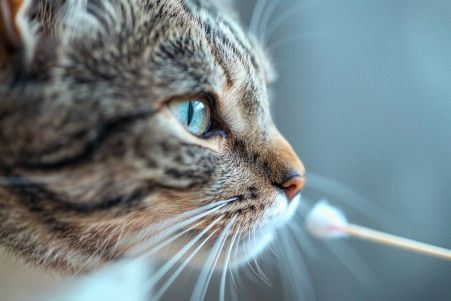Tagged With Behavior Research

Do Turtles Have Feeling in Their Shells? The Mystery of Shell Sensitivity
12 March 2024
The carapace is a highly innervated structure that has implications for everything from behavior to environmental interactions to conservation.

Do Dogs Have Adam’s Apples? Exploring Canine Laryngeal Anatomy
12 March 2024
The structure and purpose of the dog larynx, how it impacts barking, potential medical concerns, and ways to address issues that may arise.

Do Rottweilers Have Aggressive Temperaments? Debunking Aggression Misconceptions
11 March 2024
This article discusses the genetics of Rottweiler aggression, the importance of training and socialization, and how positive reinforcement can affect behavior.

Why Do Cats Sniff Each Other’s Butts? Unraveling Feline Scent Communication
11 March 2024
Knowing the reason behind why cats smell butts: a way to communicate information about identity, health, and social status through smell.

What Causes Frito Feet in Dogs? The Science Behind the Smell
11 March 2024
Causes of “Frito Feet” in dogs, including bacteria presence, paw care tips, and the role of the canine skin microbiome.

Why Do Dogs Wink? Decoding Canine Communication
10 March 2024
This article discusses the science behind dog winking, including why dogs wink, what it can indicate about their health, how you can train your dog to wink, and the connection between winking and a dog's vision and other physiological processes.

Can Dogs Masturbate? What to Know About Normal Canine Behavior
10 March 2024
This article discusses dog masturbation: why it happens, reasons for it, potential health effects, psychological causes, hormonal factors, and the role of communication.

Why Do Dogs Scratch the Bed? The Science Behind Canine Behavior
8 March 2024
Reasons why dogs may scratch at their bedding: instincts, comfort, stress, marking their territory, and medical issues.

Why Does My Cat Put His Paw on My Mouth? Decoding Feline Gestures
8 March 2024
Reasons why your cat might put their paw on your face, such as showing love, seeking attention, marking their territory, and stress-related causes.

Why Does My Cat Bite My Nose? Decoding Feline Affection & Play
8 March 2024
Learn why cats bite noses, including love bites, play, scent marking, and communication, and how to safely deal with this behavior.

Do Chinchillas Bite? Understanding Their Behavior and Prevention Tips
8 March 2024
This article discusses chinchilla bites: why they happen, how to avoid them, and how socialization, training, and health can help lower the number of bites.

Why Do Cats Like Earwax? Exploring the Feline Fascination
7 March 2024
Cats are attracted to earwax because of the smell of the proteins in it, the nutritional content that is similar to their regular diet, and their sense of smell.